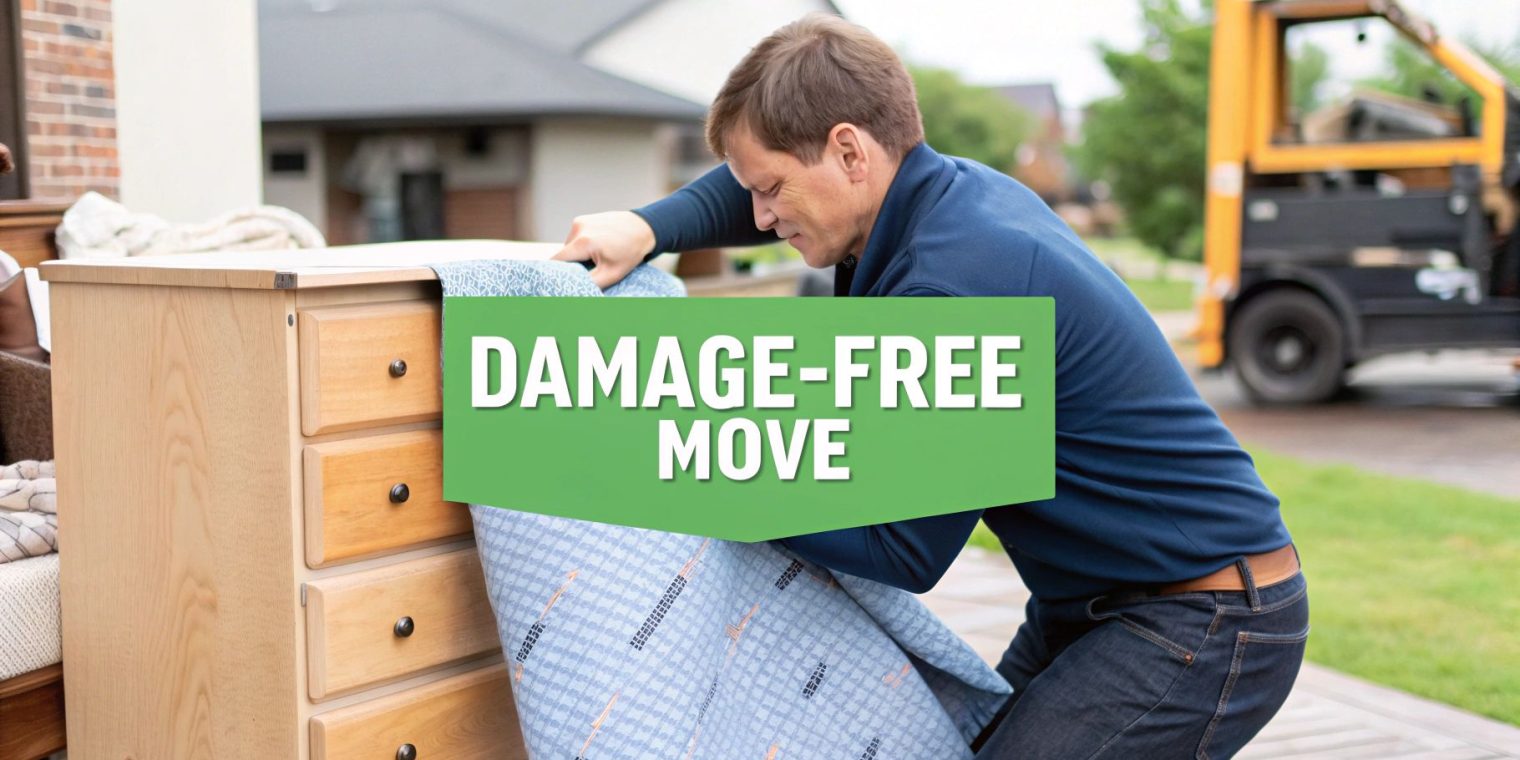When you think about moving, boxes and tape are probably the first things that come to mind. But the real secret weapon of professional movers? The humble removal blanket. These aren't your average household quilts; they're thick, tough coverings specifically designed to protect furniture and appliances from the scuffs, scratches, and dings that can happen during a move.
The Unsung Hero of a Damage-Free Move
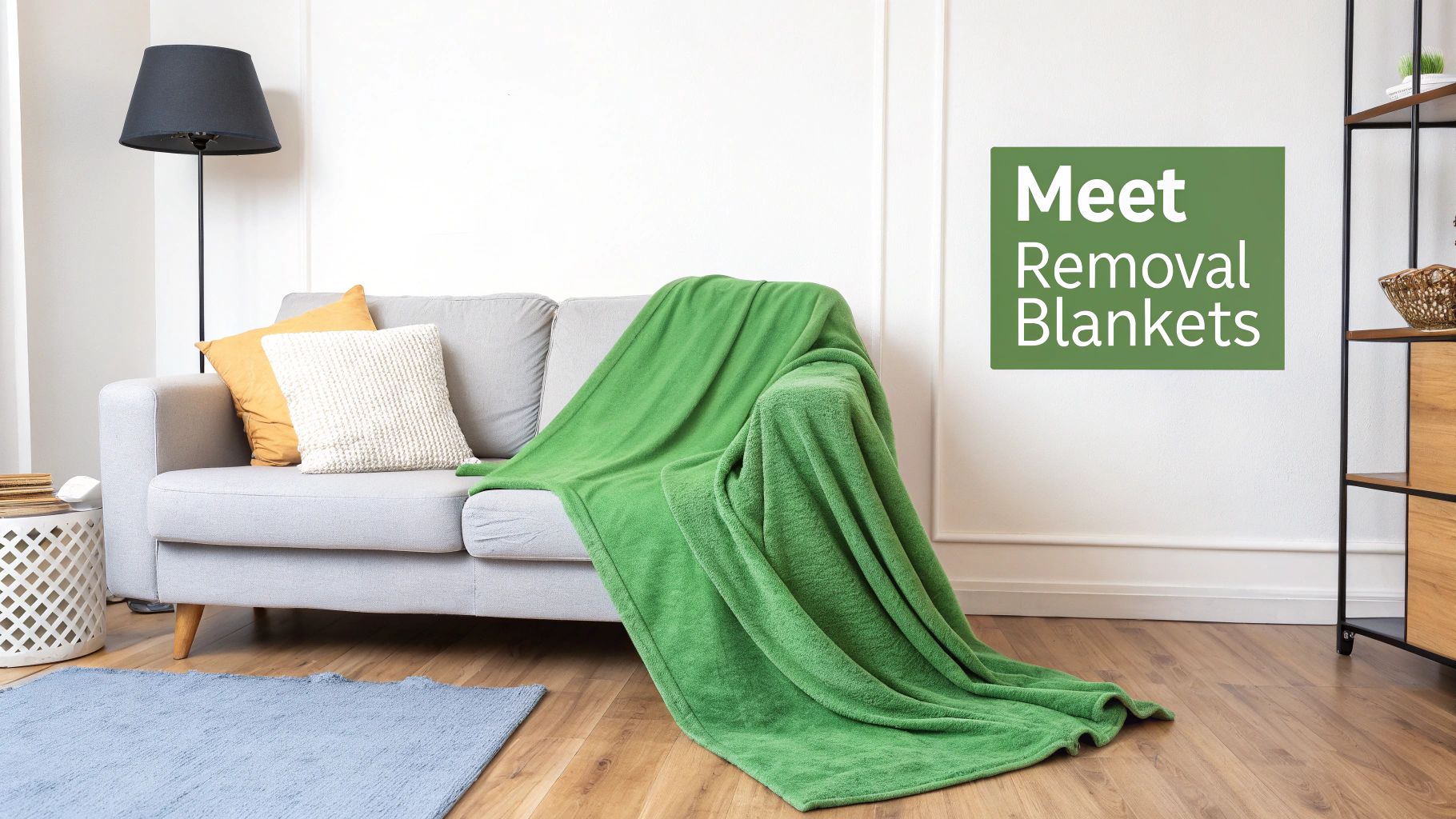
Before we get into the nitty-gritty of wrapping techniques, let's talk about why a proper removal blanket is an absolute must-have for any move. This isn't just about throwing a cover over your things; it's about creating a vital buffer against the inevitable bumps, scrapes, and shifts that happen in transit.
Think about it. You wouldn't toss your laptop in the back of a ute without a padded case. Your furniture—from that antique timber sideboard you inherited to your shiny new fridge—deserves exactly the same level of care.
More Than Just a Blanket
It can be tempting to grab a few old doonas from the linen cupboard and call it a day, but I can tell you from experience, they just don't cut it. A standard quilt falls short in every way that matters. Purpose-built removal blankets, on the other hand, are engineered for the job.
- Tough Fabric: They’re usually made from a durable, non-slip woven material that won’t easily tear and helps grip the item you're wrapping.
- Dense Padding: The cotton or synthetic batting inside is thick and designed to absorb impacts, which is what stops dents and deep scratches.
- Big Enough to Do the Job: Most removal blankets are large enough to completely wrap common pieces of furniture, leaving no vulnerable gaps.
Using a regular bedspread is a bit like putting a band-aid on a broken arm—it looks like you've done something, but it offers almost no real protection. The coarse, sturdy texture of a proper removal blanket provides the armour your valuables need to survive the journey.
The difference is stark when you see it in a real-world move. An entertainment unit wrapped correctly in a removal blanket can handle the vibrations of a long-haul trip. The same unit covered in a thin quilt is at the mercy of every single bump in the road.
A Growing Need for Protection
This isn't just an anecdotal observation; the need for proper protection is a growing trend across Australia. As more people move into and between cities, the demand for reliable moving services and high-quality gear is on the rise.
In fact, the market for blankets and quilts in Australia, which includes these specialised removal blankets, was valued at around USD 421.4 million in 2024 and is expected to keep growing. This trend really drives home how crucial these protective materials have become in the logistics and moving industry. You can dig into more data on the Australian blanket market to see the full picture.
Ultimately, investing in quality removal blankets is an investment in your own peace of mind. It’s a small price to pay to protect the value of your possessions and ensure they arrive at your new home in one piece.
How to Choose the Right Removal Blankets
Picking the right removal blankets can seem like a small detail, but getting it right is the difference between a smooth move and a day filled with scratches and dents. I’ve seen it all, and trust me, not all blankets are created equal. You wouldn't use the same protection for a solid oak wardrobe as you would for a small bedside lamp. The trick is to match the blanket to the item you're protecting.
Let's start with the material. Most professional-grade removal blankets are made from a tough polyester, a cotton blend, or a mix of the two. For big, heavy furniture with sharp corners—think dining tables or antique dressers—you’ll want a woven polyester blanket. They offer incredible strength and are far less likely to snag or tear under pressure. On the other hand, lighter, non-woven blankets are a more budget-friendly choice. They’re perfect for wrapping smaller items or for adding an extra layer of padding between things already stacked in the truck.
Understanding Weight and Size
The weight of a removal blanket, usually measured in grams per square metre (GSM), tells you almost everything you need to know about its protective power. It's simple: a higher GSM means a thicker, denser blanket that provides better cushioning against bumps and scrapes. If you’re moving something valuable or particularly heavy, always go for a blanket with a higher GSM rating.
Size is the other big factor. A standard removal blanket is typically around 1.8m x 2m. This is usually plenty to completely wrap most common pieces of furniture like armchairs, chests of drawers, and small tables. For those really large items, like a three-seater sofa or a king-size mattress, you’ll probably need to use two blankets to get full coverage with no exposed corners.
To make things a bit easier, here’s a quick reference table to help you decide.
Removal Blanket Comparison Guide
| Blanket Type | Material | Best For | Protection Level |
|---|---|---|---|
| Woven | Polyester or polyester/cotton blend | Large, heavy, or high-value furniture with sharp edges. | High |
| Non-Woven | Recycled synthetic fibres | Smaller items, light furniture, surface protection. | Medium |
| Quilted | Fabric layers with internal cotton/poly filling | General-purpose use, good for oddly shaped items. | Medium-High |
| Paper Pads | Multiple layers of paper | Economical, single-use protection for light-duty needs. | Low |
This table should give you a solid starting point for figuring out exactly what you need for your move.
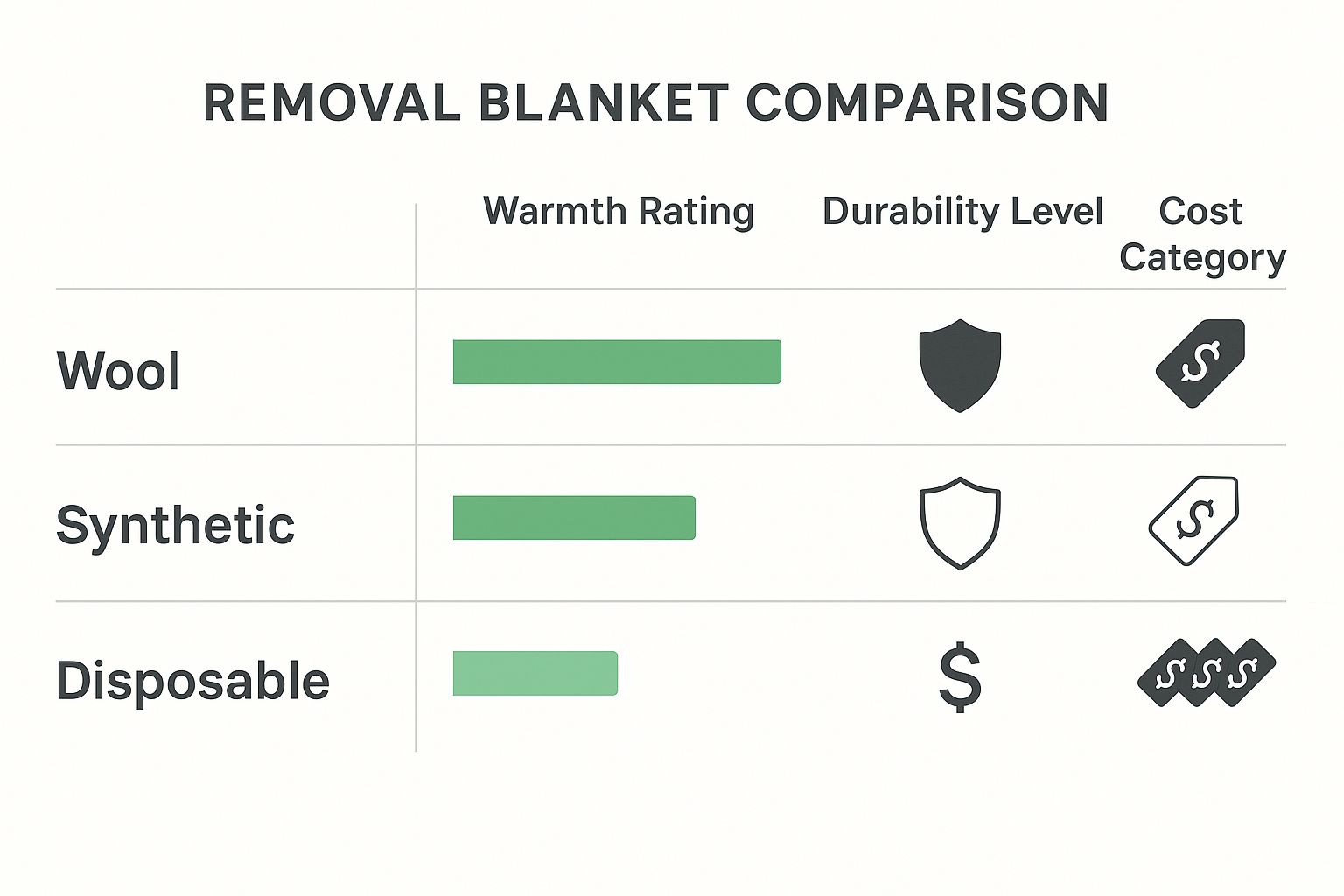
As you can see, synthetic blankets really hit the sweet spot, offering the best mix of durability, protection, and value for moving. It’s a crucial point, especially here in Australia where quality and cost can vary a lot between suppliers.
My Two Cents: If you're ever unsure, always go for a slightly heavier and larger blanket. A little extra coverage is a tiny price to pay for the peace of mind that comes with knowing your furniture is properly protected.
Of course, the blankets are just one piece of the puzzle. The same careful consideration should go into everything from choosing the right floor mat for your needs to selecting your moving team. If you’re planning a move around Perth and want professionals who understand these details, our https://emmanueltransport.net.au/joondalup-removalists/ have the experience to get the job done right.
Professional Wrapping Techniques for Your Furniture
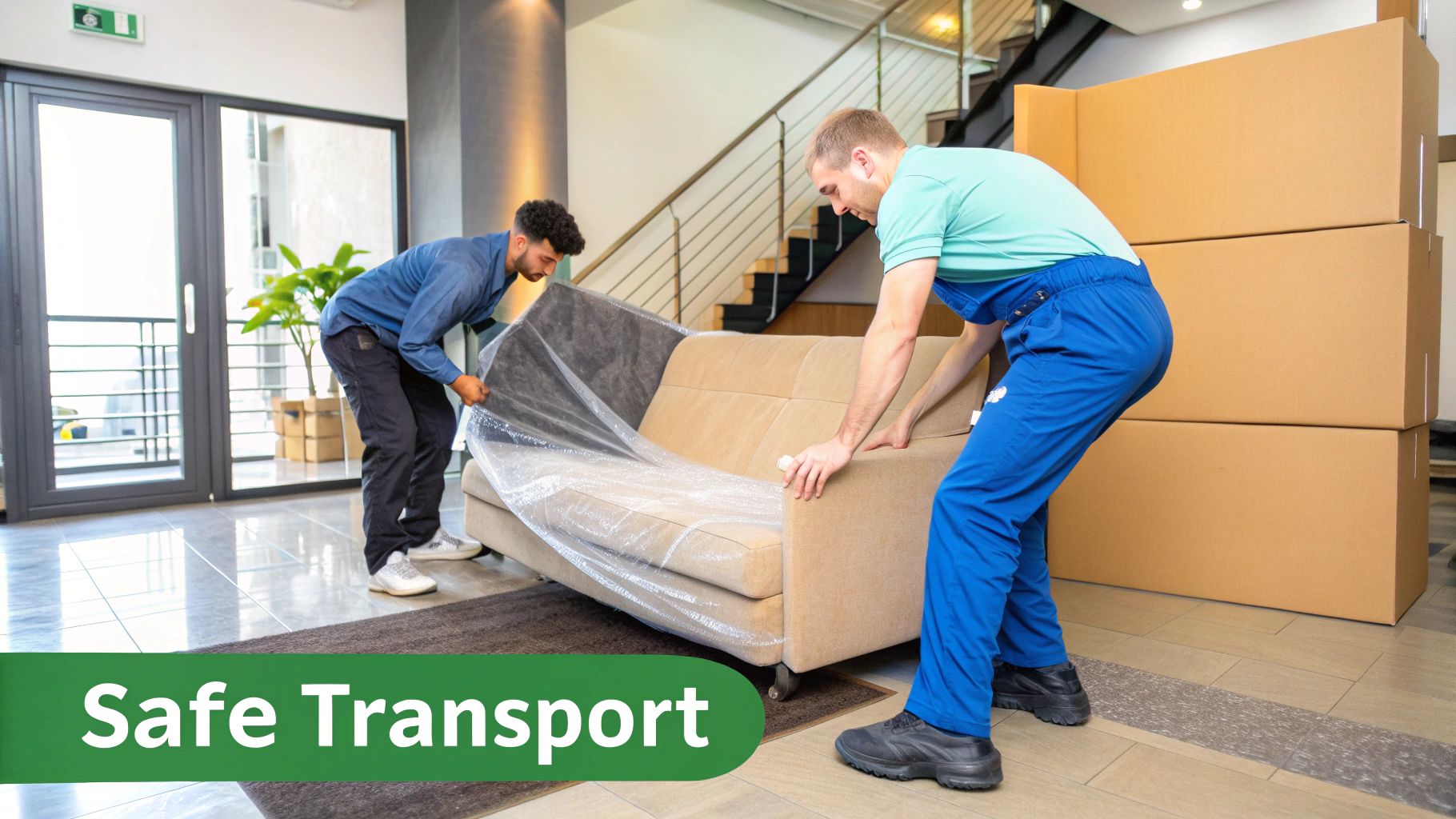
Alright, you’ve got your blankets. Now for the important part: learning how to wrap furniture like a seasoned pro. The real goal here is to create a thick, snug cocoon around each piece. You want zero exposed surfaces that could fall victim to a scrape or a bump on moving day. It’s not just about throwing a blanket over something—it's a technique, and getting it right makes all the difference.
First, give yourself some space. Drag the piece of furniture into an open area. Unfold a blanket and drape it over the item, making sure the fabric puddles on the floor on every side. If you're tackling a tallboy or a bookshelf, you’ll probably need a second blanket. Just overlap it with the first one by at least 30 centimetres to ensure there are no gaps. The aim is to see no timber, no fabric, no metal peeking through.
Mastering the Fold and Secure Method
With the furniture draped, it’s time to neaten things up. Think of it like wrapping a present. You want to fold all the excess blanket material tightly against the item. Smooth it all down so there are no loose, bunchy areas that could catch on a doorway or another piece of furniture in the truck. A tight, uniform fit is what you're after; it stops the padding from shifting around.
Now, how do you keep it all in place? You’ve got two main choices: good old packing tape or stretch wrap. But here's a crucial tip I can't stress enough: never apply packing tape directly to your furniture. Seriously. The adhesive is strong enough to rip off paint, ruin a varnish finish, or pull threads from upholstery.
- The Tape Method: The trick is to wrap the tape around the blanket so it only ever sticks to itself. A few solid bands of tape around the top, middle, and bottom sections will hold the padding securely against the furniture.
- The Stretch Wrap Method: For the ultimate protection, this is the way to go. Once the piece is blanketed, wrap the whole thing in plastic stretch wrap. This not only clamps the blankets down tight but also adds a fantastic layer of defence against dirt and moisture.
Pro Tip: From my experience, corners are the enemy. The sharp edges of a desk or the delicate feet on a dresser are always the first things to get damaged. Always give them extra attention. Fold a smaller blanket or some spare padding over these vulnerable spots before you wrap the main blanket around the whole piece. That extra cushioning can be a real lifesaver.
A Real-World Example: Protecting a Glass Coffee Table
Let's put this into practice. Imagine you've got a rectangular coffee table with a glass top—a classic high-risk item.
Start by laying a thick removal blanket over the entire table, letting it hang well over the sides. Carefully fold the excess fabric underneath, creating soft, padded bumpers around the perimeter.
The glass top is your main concern, so give it some extra love. You could even place a flat piece of cardboard over the blanket (but under the final wrap) to add some rigidity and deflect any direct pressure.
Finally, grab your stretch wrap and go to town. Circle the table multiple times, pulling the wrap taut as you go. This completely immobilises the blanket and creates a solid shield, ensuring that fragile glass top is protected from any bumps along the way.
Taking the time to wrap your furniture properly might seem tedious, but it's nothing compared to the cost and frustration of dealing with repairs later. If you're looking at a whole house full of furniture and feeling a bit out of your depth, looking into professional packing services for moving is a genuinely smart investment to make sure everything arrives in one piece.
Tackling Awkwardly Shaped and Fragile Items
Let’s be honest, not everything you own will fit neatly into a box. Every move has its share of awkward items—the bulky recliner with all its moving parts, that tall, spindly floor lamp that seems designed to break, or the massive, fragile screen of your smart TV. This is where you graduate from simply covering things to truly protecting them with removal blankets.
Wrapping these pieces is more art than science. It's about thinking like a professional removalist and creating custom padding that targets an item's specific weak points. Don't just throw a blanket over the top; you need to mould it, fold it, and secure it to create a protective cocoon.
Custom Solutions for Problem Pieces
Take a large-screen TV, for instance. The screen is everything. A great method is to create a "sandwich" with your blankets. Place one blanket flat against the front of the screen and another against the back. Then, use stretch wrap to pull it all together tightly, ensuring the entire surface is cushioned from any bumps or pressure during the move.
Something like a standard lamp presents multiple challenges: the base, the pole, and the shade. You have to treat them as separate problems.
- The Base: The heavy base can easily chip or scratch your floors. Wrap it on its own with a smaller blanket to prevent damage.
- The Pole: Run a blanket lengthwise along the pole and tape it securely to itself. Simple, but effective.
- The Lampshade: Ideally, you'd pack a fragile shade separately in a dedicated box. If you can't, a light, non-woven blanket can shield it from dust and accidental rips.
And what about chairs? The legs are always the first thing to get damaged. A quick pro tip is to bundle the legs together with a small blanket and a bit of packing tape. This stops them from catching on other furniture or getting scratched up in the truck.
A veteran mover once told me his secret was to "think like water." His point was to let the blanket flow into every gap, cover every hard edge, and leave no surface exposed. That’s the mindset you need for items with complex shapes.
When you're dealing with extremely valuable pieces, like artwork, physical protection is just one part of the equation. It's wise to look into insuring fine art for that extra layer of security. While your removal blankets are the first line of defence, having the right insurance brings total peace of mind for those truly irreplaceable items.
How to Care for and Store Your Removal Blankets
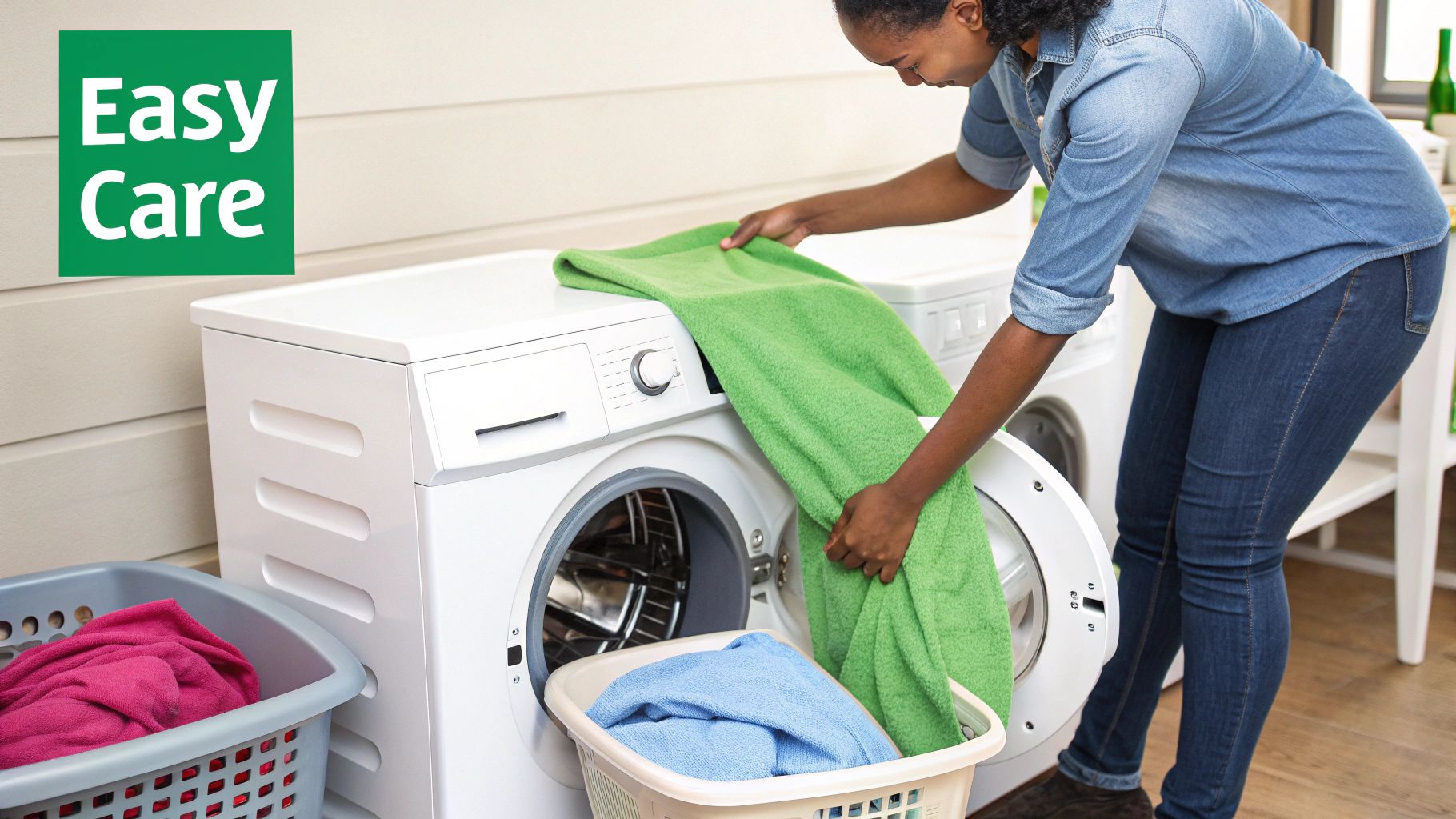
A good set of removal blankets is an investment. They’re built to last, but a little TLC after the move goes a long way in making sure they’re ready for the next one. With proper care, they’ll protect your belongings for years.
First things first, take the blankets outside and give them a really thorough shake. You’d be surprised how much dust and grit they can pick up during a move.
For light scuffs and marks, spot-cleaning with a damp cloth and a bit of mild soap usually does the trick. If they've had a particularly rough time and need a full wash, always check the manufacturer's tag first. Most can handle a machine wash on a gentle cycle, but you should always air dry them completely. Throwing them in a machine dryer can break down the padding inside, so hang them over a line instead.
Best Storage Practices
The golden rule of storing removal blankets is to make sure they are 100% dry. Seriously, don't even think about folding them up if they feel even slightly damp. That’s just asking for mould and mildew, which can be a real problem, especially in some of Australia's more humid regions.
Once they're clean and bone-dry, fold them neatly and find a good home for them. A dry, well-ventilated garage, a shed, or a storage unit is perfect. Just try to avoid any damp corners in a basement or shed.
Reusing quality moving supplies isn't just smart for your wallet; it's a great sustainable practice. It fits right in with the push to cut down on waste from moving and construction, a key focus in studies like these Victorian government sustainability findings.
A Quick Tip: If you're tight on space, vacuum-sealed bags are your best friend. They compress the blankets down to a fraction of their size and provide an airtight seal against dust, moisture, and pests until you need them again.
Getting your moving gear packed away properly is a great final step to a well-organised move. For more advice on wrapping things up, take a look at our checklist for a smooth transition into a new house.
Answering Your Top Questions About Removal Blankets
Even with the best plan, you're bound to have a few questions when it comes to the nitty-gritty of using removal blankets. That's completely normal. Getting these sorted out beforehand will make moving day go a lot smoother and save you a world of stress.
Let's dive into some of the questions we hear all the time.
So, How Many Blankets Will I Actually Need?
This is the big one, isn't it? A solid rule of thumb I've picked up over the years is to aim for one large blanket for every major piece of furniture you own. Think sofas, bed frames, large cabinets, and your big appliances.
For a typical 3-bedroom house, you’re probably looking at needing somewhere between 12 and 24 blankets. The best way to get a more accurate number is to walk through your home and do a quick tally. Count every big item that you'd be devastated to see scratched.
My advice? Always grab a few extra. You'll thank yourself when you come across that oddly shaped floor lamp or want to double-wrap your grandmother's antique dresser. They’re also perfect for laying down on the truck floor for an extra layer of protection.
Can't I Just Use My Old Quilts and Doonas?
It's tempting to think you can save a few dollars by using your old household blankets, but from my experience, it's a mistake. Your bed linen simply isn't built for the job.
Proper removal blankets are made from a dense, padded material with a non-slip, tough exterior. Your doona, on the other hand, will likely tear and offers almost no real protection from bumps and scrapes. It's just not worth risking your furniture.
Here's a pro tip: Once you've wrapped an item tightly, use packing tape to secure the blanket to itself. Never, ever tape directly onto the furniture—it can strip the finish right off wood, paint, or fabric.
If you want to be extra certain everything stays put, wrap a layer of plastic stretch wrap around the outside of the blanketed item. It's a great way to keep the blanket snug without any sticky tape touching your precious belongings.
Ready to make your next move seamless and damage-free? Trust the experts at Emmanuel Transport to handle your belongings with the care they deserve. Get your free, no-obligation quote today!

